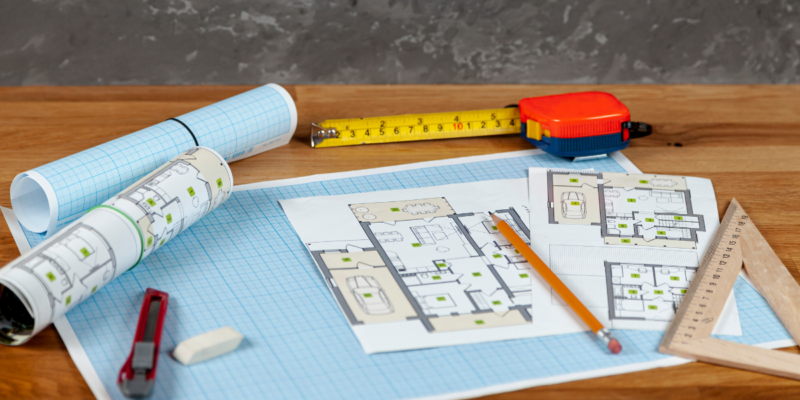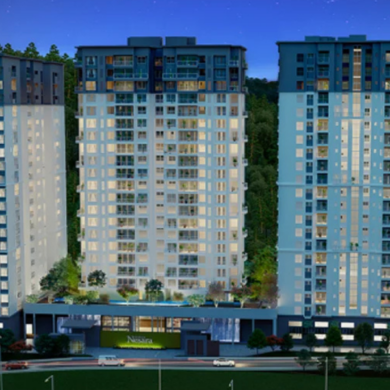
FAR calculation considers the ratio of building’s total floor area to its land plot size. Floor Area Ratio regulates building density, shapes urban growth and infrastructure, and impacts views, ventilation, and sunlight – ultimately influencing the character and liveability of cities.
Understanding FAR full form and its concept is essential, if you are planning to invest in real estate or develop property in India. This important urban planning tool determines the extent of construction allowed on a specific plot of land. It also plays a vital role in ensuring sustainable urban development.
Whether you are a first-time homebuyer, developer, or someone keen on understanding the regulations affecting property values – you can take informed decisions by understanding Floor Area Ratio. This blog explores FAR calculation, FAR formula, and many other aspects – helping you navigate the real estate domain with confidence.
Table of Contents
What is FAR?
FAR full form is Floor Area Ratio, a vital term in real estate and urban planning. It defines the ratio of a building’s total floor area, including all floors and outer walls, to the total area of the plot on which it is constructed.
FAR calculation plays a key role in determining the extent of construction allowed on a plot of land. For example, if the permissible FAR is 2 and the plot size is 1200 sq ft, then maximum possible built-up area would be 1200 × 2 = 2400 sq ft.
It is important to remember that the entire plot size may or may not be constructed upon. For example, in this 1200 sq ft plot, only 600 sq ft might be utilised for construction, and 4 floors may be built – utilising the maximum allowed built-up area of 2400 sq ft.
Higher FAR usually indicates taller buildings in densely populated urban regions, where efficient space utilisation is important. Understanding FAR full form and other terms helps you assess land usage, comply with building regulations, and take informed decisions about property investments.
Importance of FAR in Real Estate and Urban Planning
Understanding this concept can help you evaluate properties effectively and ensure compliance with urban regulations. Here is why Floor Area Ratio is important in real estate and urban planning:
- Ensures Proper Land Utilisation: It defines the maximum construction area permitted on a plot, ensuring efficient land utilisation while preventing excessive development. This maintains an optimum balance between built structures and open spaces.
- Promotes Sustainable Urban Growth: By controlling construction density, FAR promotes sustainable development, ensuring cities have adequate infrastructure and resources to accommodate their population.
- Influences Property Value: FAR directly impacts a property’s potential for development, affecting its market value. Knowing this can help you assess a property’s true potential, and take better financial decisions.
- Affects Infrastructure Planning: Urban planners rely on this metric to design essential infrastructure such as roads, drainage systems, and green spaces – creating a well-planned and liveable environment.
- Encourages Compliance with Zoning Regulations: It helps you adhere to municipal zoning laws – avoiding legal complications and ensuring your construction aligns with approved standards.
Difference between FAR and FSI
Although these terms are used interchangeably, there is a subtle difference that is important to understand. To help you grasp this distinction clearly, here is a comparison table outlining the difference between FAR and FSI.
| Aspect | FAR | FSI |
| Full Form | FAR full form is Floor Area Ratio | FSI full form is Floor Space Index |
| Definition | It is the ratio of a building’s total floor area to the size of the plot upon which it is built | It is the maximum percentage of construction permitted on a plot of land |
| Representation | Represented as a numerical ratio, e.g. 1.5 | Represented as a percentage, e.g. 150% |
Why is FAR Important in Real Estate?
This metric plays a key role in shaping real estate projects and urban landscapes. FAR is the relationship between the total built-up area of a building and the size of the plot on which it is constructed.
Its significance extends beyond technical regulations – influencing building size, design, urban planning, and property development. Understanding it can help you evaluate its impact on the real estate ecosystem and take informed investment decisions.
Read More: Buyer Builder Agreement: An Ultimate Guide
Impact of FAR on Building Size, Design, and Urban Planning
It directly determines the extent of construction allowed on a plot of land, influencing the size and design of buildings. Higher FAR encourages vertical development, leading to high-rise structures in urban areas.
This optimises land usage in densely populated areas, and balances aesthetics, functionality, and population density. For you, this ensures access to well-designed and thoughtfully planned spaces.
How FAR Affects Land Use, Zoning, and Property Development
FAR is an integral part of zoning regulations, guiding land use and preventing overcrowding. It ensures a harmonious balance between residential, commercial, and green spaces of a city. By adhering to its regulations, builders develop properties that align with infrastructure such as highways and utilities. For you, this results in better living standards and sustainable urban growth.
Benefits for Developers and Urban Planners
FAR provides clarity to builders on permissible construction, helping them optimise resources and maximise project value. Urban planners create well-structured cities that cater to population demands, while maintaining environmental sustainability. For you as a property buyer or investor, this means access to well-regulated developments that meet modern living standards.
FAR Formula & FAR Calculation
The value of floor area ratio varies from place to place, based on an array of factors including the nature of the land, availability, growth dynamics, population, infrastructure, urban expansion plans, and more.
FAR Formula
FAR = Total Building Floor Area
Gross Plot Area
- FAR full form is Floor Area Ratio
- Total Building Floor Area is the total area that all the floors of the building take up
- Gross Plot Area refers to the total area of the plot on which the property is constructed, plus the centre line of the adjoining road or street
Example
Let us say the total built-up area of a building is 3000 sq ft, and the gross plot area (the size of the plot) is 1500 sq ft.
Using the FAR formula:
FAR = Total Built-up Area / Gross Plot Area
FAR = 3000 sq ft / 1500 sq ft
FAR = 2.0
Interpretation
In the FAR formula, total built-up area is usually larger than the gross plot area, resulting in a FAR value greater than 1. This indicates that the building utilises more space vertically (multiple floors) than the horizontal land area.
- As illustrated in the above example, gross plot area is 1500 sq ft and total built-up area is 3000 sq ft, showing that the structure uses twice the land area by including multiple floors
- If the total built-up area is lesser than gross plot area, FAR will be less than 1, which applies to single-storey buildings or large plots with minimal construction
FAR: Residential and Commercial Properties
FAR values may differ between residential and commercial properties, due to zoning regulations that are designed to address the specific needs of each type of property. FAR for residential areas focuses on creating a comfortable living environment, while FAR for commercial areas prioritises maximising the available space for economic activities.
-
FAR for Residential Properties
Lower FAR: Residential properties generally have a lower FAR to maintain open spaces and prevent overcrowding. This ensures a better quality of life for residents.
Example – FAR Calculation: If the FAR for a residential area is 1.5 and the plot size is 1000 sq ft, the maximum permissible built-up area would be: 1000 × 1.5 = 1500 sq ft. In this case, a developer can construct a property with a total built-up area of 1500 sq ft.
-
FAR for Commercial Properties
Higher FAR: Commercial properties have a higher FAR to allow for larger or taller buildings, such as offices or malls, to accommodate more people and activities
Example FAR Calculation: If the FAR for a commercial area is 3.0 and the plot size is 1000 sq ft, the maximum permissible built-up area would be: 1000 × 3.0 = 3000 sq ft. This enables a developer to construct a larger building to meet commercial demands.
Why the Difference?
Residential areas prioritise liveability and open spaces, while commercial zones aim to optimise land for business activities. Different FAR values ensure that each type of zone fulfils its intended purpose, creating a balanced urban environment.
FAR plays a significant role in urban planning and development, shaping the way cities function and grow. Its regulations vary between cities – based on local needs, infrastructure capacity, and population density. Understanding these factors helps you assess how FAR impacts property development in your city, and how it can benefit you as a buyer or investor.
Key Factors That Influence FAR
-
Population Density
- Cities with higher population density, like Mumbai and Delhi, have higher FAR to accommodate vertical growth and optimise land usage
- Towns with lower population density may have lower FAR, to maintain open spaces and balanced environment
-
Infrastructure
- FAR is influenced by the capacity of a city’s infrastructure – such as roads, water supply, and drainage systems – to support additional construction
- Cities with better infrastructure can allow higher FAR, to promote urban development and earn more municipal taxes
-
Zoning Regulations
- Residential, commercial, and mixed-use zones have different FAR limits to cater to their specific purposes
- For example, commercial areas have higher FAR to support larger buildings, while residential zones are regulated to maintain liveability
-
Geographical Constraints
- Topography and environmental factors also impact FAR. Hilly areas or coastal regions have lower FAR limits, to minimise environmental risks.
- Flat, stable regions may allow higher FAR for vertical development
-
Government Policies
- Policies of state governments and municipal bodies play a critical role in defining FAR limits
- Incentives for affordable housing, green buildings, or redevelopment projects come with relaxed FAR norms, to encourage construction
-
Development Goals of the City
- Cities aiming to become business hubs, like GIFT City or Greater Noida, may allow higher FAR to support commercial development
- Conversely, cities focusing on sustainability may limit FAR, to ensure balanced growth and maintain ecological integrity
FAR Limits in Major Cities
-
Bangalore
It is divided into different zones – residential, commercial, industrial, and public / semi-public – each with specific FAR limits. For instance, FAR in residential zones ranges from 1.5 to 2.75, while commercial zones may permit FAR up to 4.
The width of the road adjacent to a property also impacts the allowable FAR. Wider roads can support higher traffic and infrastructure demands, thereby justifying higher FAR. Conversely, properties on narrower roads may be restricted to a lower FAR, to prevent congestion.
To encourage vertical growth and optimise land use, the Karnataka government has introduced the concept of Premium FAR. This provision allows property owners to purchase additional FAR beyond the standard limits, subject to specific conditions. The Karnataka government’s draft notification proposes the following premium FAR rates:
Roads 30-40 feet wide: Eligible for additional 20% of the permissible FAR
Roads 40-60 feet wide: Eligible for additional 40% of the permissible FAR
Roads wider than 60 feet: Eligible for additional 60% of the permissible FARTo acquire this premium FAR, developers need to pay a fee of at least 28% of the guidance value of the additional built-up area. This proposal strikes a balance between urban development, permissible construction density, infrastructure capacity, and generation of additional revenue for the government through guidance value and property taxes.
Eligibility: Properties must be in designated ‘impact zones’ with a minimum road width of 9 metres (~30 feet)
Cost Implication: Additional FAR can be obtained by paying a fee calculated at 50% of the property’s existing guidance value -
Mumbai
FAR values vary between the island city and its suburbs. The island city has FAR ranging from 1 to 1.33; while suburbs may have higher FSI limits, sometimes up to 3 or 4, depending on specific zones and development plans.
Wider roads and larger plots may qualify for higher FAR. For instance, plots adjacent to roads wider than 30 metres may be eligible for FAR up to 5, promoting vertical development in areas capable of supporting increased infrastructure demands.
Conclusion
Understanding Floor Area Ratio is important for anyone involved in real estate, from homebuyers to developers. FAR directly influences property values, development potential, and the overall urban landscape.
By carefully considering FAR calculation, stakeholders can take informed decisions, ensure compliance with zoning laws, and contribute to the sustainable growth of their communities. As urban areas continue to evolve, thoroughly understanding FAR remains essential for navigating the complexities of the real estate market.
FAQs
1. What does FAR stand for?
FAR stands for Floor Area Ratio – the ratio of a building's total floor area to the land area it is built on.
2. What does FAR 2.5 mean?
FAR 2.5 means the total built-up area of the building can be up to 2.5 times the size of the land plot.
3. What is the difference between FAR and FSI?
The difference between FAR and FSI lies in the representation. FAR is represented as a numerical ratio (e.g., 1.5), while FSI is represented as a percentage (e.g., 150%). They both measure the maximum permissible construction on a plot.
4. What does FAR 1.25 mean?
FAR 1.25 means that the total built-up area of the building can be 1.25 times the size of the land plot.
5. What is the difference between FAR and FSR?
There is no difference between FAR and FSR. While FAR full form is Floor Area Ratio, FSR stands for Floor Space Ratio; and both terms mean the same.
6. How is FAR calculated?
FAR is calculated by dividing the total building floor area by the gross lot area.
7. Is a balcony included in FAR?
No, an open balcony is not included in FAR.
8. What does FAR 200 mean?
FAR = 200/100 = 2. An FSI of two indicates that the total floor area of a building remains two times the built-up area of the plot on which it is built.
9. What is FAR formula?
FAR formula is: FAR = Total Building Floor Area / Gross Plot Area
10. What does FAR 2.0 mean?
FAR 2.0 means that the total built-up area of the building can be twice the size of the plot on which it is built.









